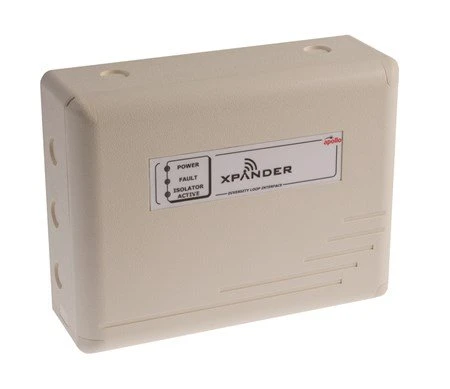Loop In Interface Unit Diversity xpander
£488.94 inc VAT £407.45 ex VAT
Description
The XPander Diversity Loop Interface Unit can monitor up to 31 XPander devices and report each devices status to an intelligent fire control panel. XPander incorporates entirely new designs with respect to the wireless communication system. A Radio Interface is connected to the loop. It communicates with the control panel using the Apollo addressable two-wire power and communications system. The interface communicates with the detection and alarm signalling devices by means of radio waves. The detectors are multistate in that they report normal, pre-alarm, fire or fault states to the radio base which transmits the information to the interface. The detectors incorporate drift compensation and report any compensation limit occurring. The radio bases and signalling devices are addressable and use a pre-set analogue value to report via the XP95 or Discovery protocol. Apart from normal and fire the bases can send pre-set analogue values to indicate low battery, detector contaminated, detector tamper and low signal strength fault conditions. The XPander Diversity Interface is connected to the loop and provides communications from the control panel to the wireless devices and vice versa. Features of the XPander Diversity Loop Interface are: It is powered from the loop. A maximum of five interfaces can be connected to a loop. Up to 31 radio devices can be logged on to each interface. The current drawn from the Interface should be taken into consideration when calculating the total load of a loop. The XPander Diversity Interface has an integral LCD display which gives information on the state of the wireless detectors. The Diversity Interface transmits and receives signals via the integral Diversity Aerials which require no adjustment or maintenance. The XPander interface aerial must be installed at least 400mm away from any metal object. The recommended minimum distance to any electrical equipment is 2 metres in all three dimensions. An 8-segment DIL switch is provided for the address of the Interface to be set. When polled by the control panel, the XPander Interface returns a pre-set analogue value of 16 in normal condition. Fire detection systems are life-saving systems and must, therefore, be highly reliable in use. Radio communications have been developed to a point where high reliability can be guaranteed, provided that the rules for the design of radio systems and installation are carefully observed. Radio communication technology in the detection has matured to the point where a standard has been drawn up as part of the EN54 family of standards for components of a fire detection system. The standard is EN54 Part 25. The frequency used by XPander is 868MHz which is the harmonised European radio frequency. Detectors should be checked regularly at the intervals indicated by the locally applicable code of practice. Apollo recommends that the detectors be checked at least once a year. If detectors appear not to be functioning correctly they should be returned to Apollo for testing. If detectors are externally dirty they can be cleaned carefully with a damp cloth using a small amount of industrial alcohol. Devices in the XPander range are powered by batteries. There are two battery packs, with current being drawn alternatively from each. It is essential that the state of the batteries be known.
- · Connects up to 31 XPander devices to an Apollo
- · Addressable loop
- · Translates radio signals from XPander detectors to the fire control panel
- · Built-in loop isolator
- · Loop-powered
- · Diversity aerial design for improved signal integrity
- · loop-powered interface operating on 868MHz
- · wireless addresses seen by control panel as normal addresses
- · remote test facility




